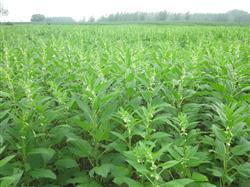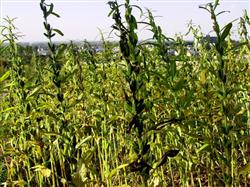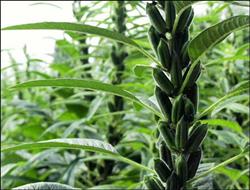What diseases should be prevented from planting white sesame?

What diseases should be prevented from planting white sesame? Please introduce the following diseases to be prevented in planting white sesame: first, the occurrence characteristics of main diseases. The main diseases of sesame are sesame stem blight, sesame wilt, sesame bacterial wilt, sesame blight and so on. 1. Stem blight of sesame. Sesame stem blight is also known as sesame stem blight, sesame black root madness and so on. It mainly harms the stems, roots and seedlings of sesame. The disease occurred at the seedling stage, the shoot of the diseased seedling wilted and died, and the root turned brown and died. After the damage to the stem, the diseased stem showed yellowish-brown water-stained spots at the beginning, and developed rapidly, turned into circumferential spots, and was dark brown in the late stage, and then the stem was hollow and easy to break. After the root was damaged, the main root and branch root gradually turned brown, and a large number of black sclerotia were formed in the root cortex, resulting in root death. The pathogen overwintered on seeds, soil and remnants of diseased plants with sclerotia. In the following year, the conidia spread in the field by wind, rain and steam, mainly from the base of the stem, root and petiole. Sesame is the most susceptible to disease at seedling stage and full flowering stage. Diseased plants can produce conidia and then spread and infect. High temperature, high humidity and heavy rain are beneficial to the epidemic of the disease, and the damage is aggravated by partial application of nitrogen fertilizer, over-dense planting and continuous cropping land. 2. Fusarium wilt of sesame. Sesame Fusarium wilt, also known as half-yellowing or yellowing, is a typical vascular bundle disease. Most of the germs invaded from the root tip and wound of the plant. after invading from the root, the bacteria entered the vessel and spread along the vessel to the stem, leaf, capsule and seed, resulting in the disease and death of the whole plant. The base of the stem of the diseased plant was reddish brown, the vascular bundle of the stem was brown, and the leaves turned yellow and wilted and withered. Sometimes limited to half of the infection, the performance of half of the disease withered and died. When it is wet, there is pink mildew in the affected area. The pathogen overwinters in the soil, in the residue of the diseased plant or inside and outside the seed. The disease began in June and reached its peak in August. Continuous cropping of sesame land, poor soil fertility and high field humidity are conducive to the epidemic of the disease. 3. Sesame bacterial wilt. Sesame bacterial wilt, commonly known as sesame plague, is a disease caused by bacteria. The pathogen invades from the root wound or from the natural orifice and spreads from the bottom up in the plant vessel. The diseased plant seemed to be short of water at the beginning, wilted during the day, returned to normal at night, and wilted at night a few days later. The outer part of the rhizome of the damaged plant showed dark brown stripes, the inner vascular bundles were brown, and there were bacteria overflow and exudation. The veins of the damaged leaves showed black-green stripes, and the diseased capsules showed dark brown stripes. The pathogen overwinters with the remains of the diseased plant in the soil and spreads by running water or farming operations. The peak of incidence is from July to August in summer. After the storm, the temperature rises suddenly, which is conducive to the epidemic of the disease. 4. Sesame blight. Sesame blight is a destructive disease. Mainly damage the base of sesame stem, stem, capsule, leaf. After the damage to the base of the stem, it first showed dark green water stains, and then showed reddish brown, depression and longitudinal split of the cortex. After the damage to the stem and capsule, the diseased part showed a dark green water stain, constricted and sunken, and produced cotton floc-like white mold. After the damage to the leaves, there are yellowish-brown disease spots, the disease spots have no obvious wheel pattern. The pathogen overwintered in the remnant of the diseased plant with hyphae or oospores. In the following year, the pathogen infected the base of the stem, produced sporangia, spread by wind, rain and running water, and expanded and re-infected. The disease began in the budding stage of sesame in July and reached the peak in August. It's rainy and damp. Second, integrated control techniques. 1. Selection of disease-resistant varieties and seed treatment. Varieties with good quality, high yield, waterlogging tolerance and strong disease resistance were selected, such as Yuzhi 8, Yizhi 1 and so on. Soak the seeds in 55 ℃ warm water for 10 minutes or 60 ℃ warm water for 5 minutes before sowing, then sow the seeds after drying. Or seed dressing with pentachloronitrobenzene plus thiram (1:1), which accounts for 0.5-1% of the seed weight, or soaking the seed with 0.5% copper sulfate solution for half an hour has a better control effect. 2. Agricultural prevention and control. Sesame soil-borne diseases and insect pests are serious, and continuous cropping is most avoided. the rotation of sesame with cotton, sweet potato and gramineous crops for 3-5 years can better control the epidemic of the disease. After the sesame is harvested, the diseased remains in the field should be removed in time and burned or buried deeply in order to reduce the source of overwintering bacteria. Remove the diseased plants in time and take them out of the field for destruction to prevent the spread of germs. Strengthen the management of fertilizer and water, increase the application of base fertilizer, the base fertilizer is mainly medium and late-acting organic fertilizer, and mixed application of phosphorus and potassium fertilizer, no or less nitrogen fertilizer at seedling stage to cultivate healthy seedlings and make it difficult for bacteria to invade. High border cultivation is adopted to clear ditches and drain in time to prevent stagnant water in the field and reduce the humidity in the field. 3. Chemical control. The prevention and control of sesame diseases should be based on agricultural control, and chemical control should be controlled by spraying protection before the occurrence of the disease or the use of drugs at the initial stage of the disease. The control agents include 37% chlorhexidine wettable powder 800x solution, 40% carbendazim suspension 700x liquid, 50% methyl topiramate wettable powder 800x 1000 fold solution, 80% copper sulfate wettable powder 800x liquid, and so on. Click to get more sesame planting techniques click to get more food crop planting techniques
- Prev

How to prevent from falling down when planting sesame?
What are the common diseases of sesame? Please introduce the common diseases of sesame: first, the main diseases of sesame. Sesame stem blight, commonly known as "black root disease" and "black stem disease", is the most important disease in sesame production, with a general incidence of 10%, 15% and 60%, 80%, respectively, which mainly occurs in sesame flowering.
- Next

What problems should be paid attention to in planting black sesame?
What problems should be paid attention to in planting black sesame? Please give instructions to plant black sesame seeds to pay attention to the following problems: 1. Soil preparation and fertilization: choose sandy loam or loam fields with loose soil, good air permeability and medium-high fertility to plant, avoid continuous cropping. Soil preparation and fertilization at the end of May and the beginning of June, applying urea vegetable 10Mu 15kg or ammonium bicarbonate 20-2 per mu.
Related
- The first cup of black tea in spring, the flavor and history of tea gardens in Kenya, Africa
- The computer can not only choose potatoes, but also grow tea rice. AI will grow winter oolong tea champion.
- It is not only the inflated tea bitten by insects, but also engraved with the four seasons tea in Beipu.
- The Oriental Beauty Tea Festival in Zhuxian County takes the stage at the weekend to experience the plus-size feast of oil tea.
- & quot; Oriental Beauty Tea & Exploration of Emei in Hsinchu, the hometown of quot;
- The new variety of strawberry "Tainong 1" dessert is the first choice with mellow aroma. Crimson gorgeous
- History of Tea in Taiwan: from Wild Inner Mountain to Export Tea Garden
- Two types of Taiwan Oriental Beauty Black Tea won the British three-Star Award for Childhood Tea Xiang Zhang Jiaqi changed from pilot to champion tea maker.
- Banana species and varieties: the planting history of Taiwan Xianren banana and dwarf banana is long, is banana disease resistant?
- Coffee planting Technology: Qianjie Coffee from Seedling to harvesting

